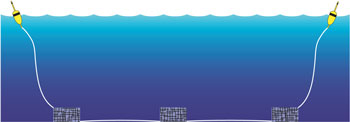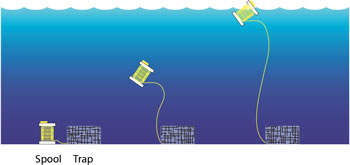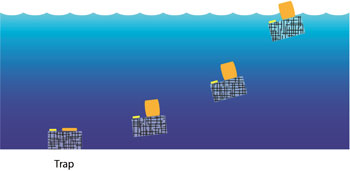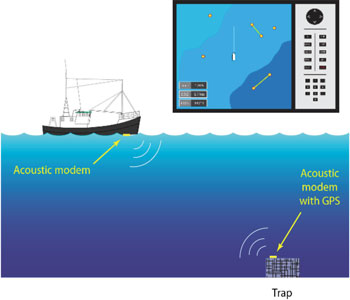Fed Law Driving Development of Ropeless Trap Technology

Conventional trap, vertical line and buoy arrangement.

Buoyant spool with rope released by the acoustic signal.

Gas released from the cylinder by acoustic signal inflates the bag on trap.

Currently available technology enables communication between the modem on the surface vessels and the modem on objects on the bottom.
Scientists at the Woods Hole Oceanographic Institute (WHOI) in Woods Hole, Mass., have been working against the clock to find a way to use sophisticated technology rather than vertical lines to bring lobster traps to the surface. Vertical lines from the trap on the bottom to a buoy at the surface mark the trap’s location, identify the owner and enable the trap to be brought to the surface.
The federal Marine Mammal Protection Act of 1996, evidence of right whale entanglements in fishing lines, lawsuits against the National Marine Fisheries Service and a rapidly declining right whale population, which is already small, are driving federal action on vertical lobster trap lines.
Mark Baumgartner, associate scientist with the WHOI and one of the scientists working on ropeless trap technology, said technology to get traps to the surface without rope already exists. The problem to be solved is how to adapt that technology for practical use in the lobster industry. Marine scientists and the U.S. Navy have for years used existing technology to raise equipment from the ocean floor, said Baumgartner.
There are currently three options to vertical lines being considered. All use a sound signal to communicate with the trap on the bottom and engage flotation at the trap. Cell phones emit an electromagnetic signal. Sound or acoustic signals, like a depth finder, travel faster in water. A signal device locates the trap and sends a sound signal. The signal is embedded with information that identifies the device as an authorized user.
In the first option the signal opens a bag on the trap to release a flotation device, something like a buoy, with a vertical line attached. In the second, the signal opens a mechanical anchor attachment on the trap to release a floating spool with rope wound around it that floats to the surface. The third uses the signal to release gas from a cylinder to inflate a flotation bag on the trap.
Baumgartner said it is important for engineers and fishermen to work together to find something that works. “Fishermen are notoriously clever. If we can get the equipment to the fishermen, give them the tools, together we can develop this,” said Baumgartner.
Baumgartner said vertical lines were always a more difficult problem. “Floating groundlines were more apparent and easier for fishermen to change to sinking rope. Vertical lines are more difficult for fishermen because it requires changing the way they fish. Because the right whale population has been declining for several years, now there is a greater urgency,”said Baumgartner.
ASAP is the timeline for the project, said Baumgartner. The process will include working with a small number of fishermen who will fish with experimental options over a couple of years. Opening closed areas in Massachusetts to fishermen willing to experiment with ropeless gear is being considered. Incentivizing participation with payment for time using the gear is another option. Concerns about closures here and in Canada may motivate some to participate, said Baumgartner.
